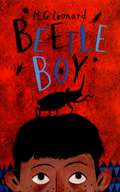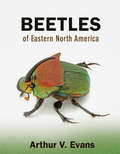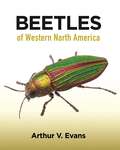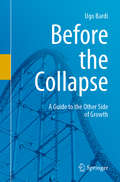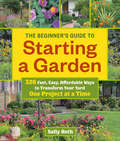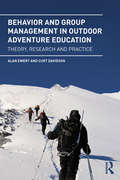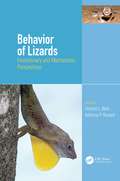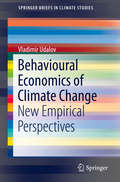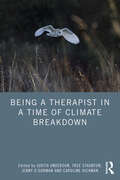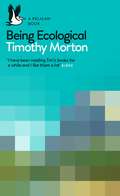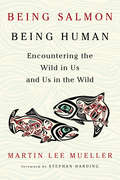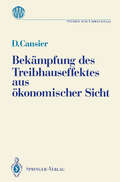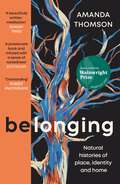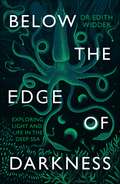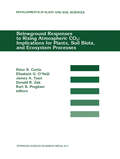- Table View
- List View
Beetle Boy (The Battle Of The Beetles Ser.)
by M. G. LeonardDarkus is miserable. His dad has disappeared, and now he is living next door to the most disgusting neighbours ever. A giant beetle called Baxter comes to his rescue. But can the two solve the mystery of his dad's disappearance, especially when links emerge to cruel Lucretia Cutter and her penchant for beetle jewellery? A coffee-mug mountain, home to a million insects, could provide the answer - if Darkus and Baxter are brave enough to find it .
Beetles of Eastern North America (PDF)
by Arthur V. EvansBeetles of Eastern North America is a landmark book--the most comprehensive full-color guide to the remarkably diverse and beautiful beetles of the United States and Canada east of the Mississippi River. It is the first color-illustrated guide to cover 1,406 species in all 115 families that occur in the region--and the first new in-depth guide to the region in more than forty years. Lavishly illustrated with over 1,500 stunning color images by some of the best insect photographers in North America, the book features an engaging and authoritative text by noted beetle expert Arthur Evans.Extensive introductory sections provide essential information on beetle anatomy, reproduction, development, natural history, behavior, and conservation. Also included are tips on where and when to find beetles; how to photograph, collect, and rear beetles; and how to contribute to research. Each family and species account presents concise and easy-to-understand information on identification, natural history, collecting, and geographic range. Organized by family, the book also includes an illustrated key to the most common beetle families, with 31 drawings that aid identification, and features current information on distribution, biology, and taxonomy not found in other guides.An unmatched guide to the rich variety of eastern North American beetles, this is an essential book for amateur naturalists, nature photographers, insect enthusiasts, students, and professional entomologists and other biologists.Provides the only comprehensive, authoritative, and accessible full-color treatment of the region's beetlesCovers 1,406 species in all 115 families east of the Mississippi RiverFeatures more than 1,500 stunning color images from top photographersPresents concise information on identification, natural history, collecting, and geographic range for each species and familyIncludes an illustrated key to the most common beetle families
Beetles of Western North America
by Arthur V. EvansFrom the author of the acclaimed Beetles of Eastern North America, a triumphant follow-up guide to western beetles, lavishly illustrated with more than 1,500 stunning color photographsBeetles of Western North America is a landmark book—the only comprehensive color photographic guide to the remarkably diverse and beautiful beetles of the United States and Canada west of the Continental Divide. A triumphant follow-up to Arthur Evans’s highly regarded Beetles of Eastern North America, this engaging and accessible book covers 1,428 species from all 131 families that occur in the West. The book is lavishly illustrated with more than 1,500 stunning images by some of the best insect photographers in North America.An extensive introduction provides essential information on beetle anatomy, natural history, behavior, and conservation, as well as tips on where and when to find beetles; how to photograph, collect, and rear them; and how to contribute to research. Beetles of Western North America is organized by family, and each family and species account presents concise and easy-to-understand information on identification, natural history, collecting, and geographic range. The book includes current information on distribution, biology, and taxonomy not found in other guides, and features an illustrated identification key to the most common beetle families.An unmatched guide to the rich variety of western North American beetle fauna, this is a must-have book for amateur naturalists, nature photographers, insect enthusiasts, students, professional entomologists, and other biologists.The only comprehensive color photographic guide to the region’s beetlesCovers 1,428 species from all 131 families west of the Continental Divide, and offers tips for identifying more than 450 additional speciesFeatures more than 1,500 stunning color photographsPresents concise information on identification, natural history, collecting, and geographic range for each species and familyIncludes an illustrated identification key to the most common beetle families
Before Environmental Law: A History of a Vanishing Continent
by Professor Benjamin J RichardsonThis landmark book unveils the history of defending Australia's natural environment and examines the subject's legal and political contexts from the birth of the nation in 1901 until the advent of the so-called modern era of environmental regulation in the late 1960s. It rejects the mythology that Australia lacked environmental law before the late 1960s in revealing how many of today's environmental laws, from pollution control to nature conservation, emerged from precedents or events much earlier in the 20th century. This history however reveals a discrepancy between lawmakers' greater efficacy to exploit rather than protect the environment, a discrepancy that grew as nature's backlash intensified in a rapidly degrading continent colonised to build the Australian nation. In exploring these dynamics, the book offers a rich tapestry of case studies illustrated with historic photographs that show the origins of Australia's environmental laws and how they borrowed from international precedents or furnished lessons for other nations. Through its multi-disciplinary enquiry, the book offers scholars and students of environmental law, legal history and the environmental humanities a unique story about the failures and successes in the making of environmental law.
Before Environmental Law: A History of a Vanishing Continent
by Professor Benjamin J RichardsonThis landmark book unveils the history of defending Australia's natural environment and examines the subject's legal and political contexts from the birth of the nation in 1901 until the advent of the so-called modern era of environmental regulation in the late 1960s. It rejects the mythology that Australia lacked environmental law before the late 1960s in revealing how many of today's environmental laws, from pollution control to nature conservation, emerged from precedents or events much earlier in the 20th century. This history however reveals a discrepancy between lawmakers' greater efficacy to exploit rather than protect the environment, a discrepancy that grew as nature's backlash intensified in a rapidly degrading continent colonised to build the Australian nation. In exploring these dynamics, the book offers a rich tapestry of case studies illustrated with historic photographs that show the origins of Australia's environmental laws and how they borrowed from international precedents or furnished lessons for other nations. Through its multi-disciplinary enquiry, the book offers scholars and students of environmental law, legal history and the environmental humanities a unique story about the failures and successes in the making of environmental law.
Before the Collapse: A Guide to the Other Side of Growth
by Ugo BardiNobody has to tell you that when things go bad, they go bad quickly and seemingly in bunches. Complicated structures like buildings or bridges are slow and laborious to build but, with a design flaw or enough explosive energy, take only seconds to collapse. This fate can befall a company, the stock market, or your house or town after a natural disaster, and the metaphor extends to economies, governments, and even whole societies. As we proceed blindly and incrementally in one direction or another, collapse often takes us by surprise. We step over what you will come to know as a “Seneca cliff”, which is named after the ancient Roman philosopher, Lucius Annaeus Seneca, who was the first to observe the ubiquitous truth that growth is slow but ruin is rapid. Modern science, like ancient philosophy, tell us that collapse is not a bug; it is a feature of the universe. Understanding this reality will help you to see and navigate the Seneca cliffs of life, or what Malcolm Gladwell called “tipping points.” Efforts to stave off collapse often mean that the cliff will be even steeper when you step over it. But the good news is that what looks to you like a collapse may be nothing more than the passage to a new condition that is better than the old.This book gives deeper meaning to familiar adages such as “it’s a house of cards”, “let nature take its course”, “reach a tipping point”, or the popular Silicon Valley expression, “fail fast, fail often.” As the old Roman philosopher noted, “nothing that exists today is not the result of a past collapse”, and this is the basis of what we call “The Seneca Strategy.” This engaging and insightful book will help you to use the Seneca Strategy to face failure and collapse at all scales, to understand why change may be inevitable, and to navigate the swirl of events that frequently threaten your balance and happiness. You will learn:How ancient philosophy and modern science agree that failure and collapse are normal features of the universePrinciples that help us manage, rather than be managed by, the biggest challenges of our lives and times Why technological progress may not prevent economic or societal collapseWhy the best strategy to oppose failure is not to resist at all costsHow you can “rebound” after collapse, to do better than before, and to avoid the same mistakes.
Begin Again
by Oliver JeffersA powerful, thoughtful and bold comment on humanity and its future from one of today’s most thought-provoking artists.
A Beginner’s Guide to Microarrays
by Eric M. BlalockA Beginner's Guide to Microarrays addresses two audiences - the core facility manager who produces, hybridizes, and scans arrays, and the basic research scientist who will be performing the analysis and interpreting the results. User friendly coverage and detailed protocols are provided for the technical steps and procedures involved in many facets of microarray technology, including: -Cleaning and coating glass slides, -Designing oligonucleotide probes, -Constructing arrays for the detection and quantification of different bacterial species, -Preparing spotting solutions, -Troubleshooting spotting problems, -Setting up and running a core facility, -Normalizing background signal and controlling for systematic variance, -Designing experiments for maximum effect, -Analyzing data with statistical procedures, -Clustering data with machine-learning protocols.
The Beginner's Guide to Starting a Garden: 326 Fast, Easy, Affordable Ways to Transform Your Yard One Project at a Time
by Sally RothThe Beginner&’s Guide to Starting a Garden: 326 Fast, Easy, Affordable Ways to Transform Your Yard One Project at a Time simplifies the garden design process by showing you how to tackle one small area at a time.
Behavior and Group Management in Outdoor Adventure Education: Theory, research and practice
by Alan Ewert Curt DavidsonOutdoor adventure activities are becoming an increasingly popular part of physical education programs. The physical risks of these activities are often foremost in the minds of both instructors and participants, yet it is managing group behavior which can prove to be the most difficult. This is the first book for students and practitioners to address this essential aspect of outdoor adventure education (OAE). Outlining key evidence-based training practices, this book explains how to interact with groups ranging from adolescents to military veterans within a variety of outdoor adventure education contexts. It provides practical advice on how to promote positive behavior, while also offering guidance on how to mitigate negative behavior and manage a variety of challenging behavioral issues. With ten chapters full of real world examples from rock climbing to wilderness trekking, it provides a comprehensive guide to understanding the complexities of behavioral group management (BGM) in theory and practice. This book is vital reading for students training to be outdoor physical education instructors and for practitioners looking to enhance their group management skills.
Behavior and Group Management in Outdoor Adventure Education: Theory, research and practice
by Alan Ewert Curt DavidsonOutdoor adventure activities are becoming an increasingly popular part of physical education programs. The physical risks of these activities are often foremost in the minds of both instructors and participants, yet it is managing group behavior which can prove to be the most difficult. This is the first book for students and practitioners to address this essential aspect of outdoor adventure education (OAE). Outlining key evidence-based training practices, this book explains how to interact with groups ranging from adolescents to military veterans within a variety of outdoor adventure education contexts. It provides practical advice on how to promote positive behavior, while also offering guidance on how to mitigate negative behavior and manage a variety of challenging behavioral issues. With ten chapters full of real world examples from rock climbing to wilderness trekking, it provides a comprehensive guide to understanding the complexities of behavioral group management (BGM) in theory and practice. This book is vital reading for students training to be outdoor physical education instructors and for practitioners looking to enhance their group management skills.
Behavior of Lizards: Evolutionary and Mechanistic Perspectives
by Vincent L. Bels Anthony P. RussellKey features: Presents a contemporary snapshot of the mechanisms underlying the evolution and adaptation of behavior Explores how genetics, epigenetics, development, and environment shape behavior Discusses a broad range of behavioral repertoires and responses, including those related to thermoregulatory, foraging, predatory, displaying, social and escape strategies. Examines physiological and sensory mechanisms Covers the effects of various aspects of global change on behavior, with chapters that focus on the impacts of climate change on hydroregulatory behavior and behavioral responses to the effects of habitat alteration resulting from human-mediated change and colonization by invasive species. Lizards serve as focal organisms for many of biological questions related to evolution, ecology, physiology, and morphology. They are studied at multiple spatial and temporal scales, from the individual to the community level. This book, authored by expert contributors from around the world, explores behaviors underlying the evolution and adaptation of these organisms. It covers conceptual, empirical, and methodological approaches to the understanding of the role that natural and sexual selection play in molding the behavioral traits of lizards. This thorough, illustrated reference should stimulate discussion of the conceptual and methodological approaches for studying the behavioral traits of these fascinating and highly diverse vertebrates.
Behavior of Lizards: Evolutionary and Mechanistic Perspectives
by Vincent Bels Anthony RussellKey features: Presents a contemporary snapshot of the mechanisms underlying the evolution and adaptation of behavior Explores how genetics, epigenetics, development, and environment shape behavior Discusses a broad range of behavioral repertoires and responses, including those related to thermoregulatory, foraging, predatory, displaying, social and escape strategies. Examines physiological and sensory mechanisms Covers the effects of various aspects of global change on behavior, with chapters that focus on the impacts of climate change on hydroregulatory behavior and behavioral responses to the effects of habitat alteration resulting from human-mediated change and colonization by invasive species. Lizards serve as focal organisms for many of biological questions related to evolution, ecology, physiology, and morphology. They are studied at multiple spatial and temporal scales, from the individual to the community level. This book, authored by expert contributors from around the world, explores behaviors underlying the evolution and adaptation of these organisms. It covers conceptual, empirical, and methodological approaches to the understanding of the role that natural and sexual selection play in molding the behavioral traits of lizards. This thorough, illustrated reference should stimulate discussion of the conceptual and methodological approaches for studying the behavioral traits of these fascinating and highly diverse vertebrates.
Behaviour And Conservation (Conservation Biology Ser. #No.2)
by L. Morris Gosling William J. SutherlandHow does an understanding of the behaviour of a given animal species contribute to its conservation? The answer to this question has profound consequences for our efforts to conserve endangered species. Behaviour and Conservation links the extraordinary advances that have been made in behavioural ecology over the last 30 years with the new discipline of conservation biology. It uses the power of an evolutionary approach to help solve problems in practical conservation, and suggests a new direction for behavioural ecology. The book addresses the ways in which behaviour and conservation interact, investigating the conservation impact of people, habitat loss and fragmentation, threats to wild populations of animals,
Behavioural Adaptations of Desert Animals (Adaptations of Desert Organisms)
by Giovanni CostaAfter a brief survey of biotopic and vegetational features and an account of the main groups of desert animals, the most unusual patterns of the behaviour of the xerophilous fauna are examined. The importance of the thermohygric regulation and self-protective and locomotor mechanisms to the survival of arid-adapted animals is emphasized and various adaptations in the alimentary, reproductive and social spheres are analyzed.The clear and fluent treatment will awaken the interest of the reading public, from the amateur naturalists to research scientists.
Behavioural Ecology of Western Palearctic Falcons
by Giovanni LeonardiThis monograph is the result of eight years of bibliographical and field research concerning several behavioural ecology aspects of the Palaearctic falcons. For a while, this book grew along with “The Lanner falcon” published in 2015 and revised in 2017. In both books the main aim was to provide a clear overview of the biology and ecology of these species. In fact in the last 20 years, the number of publications on falcons has grown tremendously and, in parallel, also those belonging to the so-called "grey literature". The number of people involved is also increased by including both academics and nature lovers. Many previously published books emphasized identification, and offered little insights on the behavioural and ecological aspects of the species. Very often, the research on behavioural ecology remains closed within the confines of academic community. By contrast, a multitude of basic data is scattered in countless articles published in local magazines. Many falcon species are easy to observe and study (such as kestrels) but others are more rare and localized. In order to understand the survival strategies adopted by this group of avian predators, it is necessary not to lose sight of the overall picture. This book tries to explain the different survival strategies by examining, through a few essential chapters, some crucial aspects for all species. The first chapter provides information on the genus Falco, its genetics, evolution and morphological peculiarities. The other chapters deal with reproductive strategies, competition, exploitation of resources, dispersal patterns, communication and sociality. One of the main objectives of this book is to produce an accessible but scholarly curated source of reference. By understanding the most common species, it is possible to provide a working framework for rarer, and especially threatened, falcon species.
Behavioural Economics of Climate Change: New Empirical Perspectives (Springerbriefs In Climate Studies)
by Vladimir UdalovThis book investigates various kinds of climate change mitigation behaviour, which range from a general support of environmental policy to concrete energy-saving activities, in selected countries. Drawing on extensive national and international survey data, the analysis has the following main objectives: to identify potential determinants of individuals’ renewable energy support, and to analyse the impact of experiences with natural disasters on individuals’ choice between economic growth and environmental protection. Moreover, it examines the role of environmental motivations behind direct daily energy-saving behaviour. The empirical results reveal that various types of climate change mitigation behaviour are not only driven by a mixture of environmental and non-environmental/economic motivations but also depend on external circumstances such as natural disasters. Since CO2 emission dynamics stem to some extent from the choices people make every day in their roles as consumers, investors and citizens, the new findings presented are also valuable from a policy perspective.
Being a Therapist in a Time of Climate Breakdown
by Judith Anderson Tree Staunton Jenny O’Gorman Caroline HickmanThis book introduces readers to the known psychological aspects of climate change as a pressing global concern and explores how they are relevant to current and future clinical practice.Arguing that it is vital for ecological concerns to enter the therapy room, this book calls for change from regulatory bodies, training institutes and individual practitioners. The book includes original thinking and research by practitioners from a range of perspectives, including psychodynamic, eco-systemic and integrative. It considers how our different modalities and ways of working need to be adapted to be applicable to the ecological crises. It includes Voices from people who are not practitioners about their experience including how they see the role of therapy. Chapters deal with topics from climate science, including the emotional and mental health impacts of climate breakdown, professional ethics and wider systemic understandings of current therapeutic approaches. Also discussed are the practice-based implications of becoming a climate-aware therapist, eco-psychosocial approaches and the inextricable links between the climate crises and racism, colonialism and social injustice. Being a Therapist in a Time of Climate Breakdown will enable therapists and mental health professionals across a range of modalities to engage with their own thoughts and feelings about climate breakdown and consider how it both changes and reinforces aspects of their therapeutic work.
Being a Therapist in a Time of Climate Breakdown
This book introduces readers to the known psychological aspects of climate change as a pressing global concern and explores how they are relevant to current and future clinical practice.Arguing that it is vital for ecological concerns to enter the therapy room, this book calls for change from regulatory bodies, training institutes and individual practitioners. The book includes original thinking and research by practitioners from a range of perspectives, including psychodynamic, eco-systemic and integrative. It considers how our different modalities and ways of working need to be adapted to be applicable to the ecological crises. It includes Voices from people who are not practitioners about their experience including how they see the role of therapy. Chapters deal with topics from climate science, including the emotional and mental health impacts of climate breakdown, professional ethics and wider systemic understandings of current therapeutic approaches. Also discussed are the practice-based implications of becoming a climate-aware therapist, eco-psychosocial approaches and the inextricable links between the climate crises and racism, colonialism and social injustice. Being a Therapist in a Time of Climate Breakdown will enable therapists and mental health professionals across a range of modalities to engage with their own thoughts and feelings about climate breakdown and consider how it both changes and reinforces aspects of their therapeutic work.
Being Ecological
by Timothy Morton'To read Being Ecological is to be caught up in a brilliant display of intellectual pyrotechnics' P.D.Smith, GuardianWhy is everything we think we know about ecology wrong?Is there really any difference between 'humans' and 'nature'?Does this mean we even have a future?Don't care about ecology? This book is for you. Timothy Morton, who has been called 'Our most popular guide to the new epoch' (Guardian), sets out to show us that whether we know it or not, we already have the capacity and the will to change the way we understand the place of humans in the world, and our very understanding of the term 'ecology'. A cross-disciplinarian who has collaborated with everyone from Björk to Hans Ulrich Obrist, Morton is also a member of the object-oriented philosophy movement, a group of forward-looking thinkers who are grappling with modern-day notions of subjectivity and objectivity, while also offering fascinating new understandings of Heidegger and Kant. Calling the volume a book containing 'no ecological facts', Morton confronts the 'information dump' fatigue of the digital age, and offers an invigorated approach to creating a liveable future.
Being Salmon, Being Human: Encountering the Wild in Us and Us in the Wild
by Stephan Harding Martin Lee MuellerNautilus Award Silver Medal Winner, Ecology & Environment In search of a new story for our place on earth Being Salmon, Being Human examines Western culture’s tragic alienation from nature by focusing on the relationship between people and salmon—weaving together key narratives about the Norwegian salmon industry as well as wild salmon in indigenous cultures of the Pacific Northwest. Mueller uses this lens to articulate a comprehensive critique of human exceptionalism, directly challenging the four-hundred-year-old notion that other animals are nothing but complicated machines without rich inner lives and that Earth is a passive backdrop to human experience. Being fully human, he argues, means experiencing the intersection of our horizon of understanding with that of other animals. Salmon are the test case for this. Mueller experiments, in evocative narrative passages, with imagining the world as a salmon might see it, and considering how this enriches our understanding of humanity in the process. Being Salmon, Being Human is both a philosophical and a narrative work, rewarding readers with insightful interpretations of major philosophers—Descartes, Heidegger, Abram, and many more—and reflections on the human–Earth relationship. It stands alongside Abram’s Spell of the Sensuous and Becoming Animal, as well as Andreas Weber’s The Biology of Wonder and Matter and Desire—heralding a new “Copernican revolution” in the fields of biology, ecology, and philosophy.
Bekämpfung des Treibhauseffektes aus ökonomischer Sicht: Ergebnisse des Ladenburger Kollegs „Umweltstaat“ der Gottlieb Daimler- und Karl Benz-Stiftung (Ladenburger Kolleg Studien zum Umweltstaat)
by Dieter CansierWas kann national und international wirklich gegen die dro- hende Klimakatastrophe getan werden? F}r das in diesem Buch vorgestellte internationale Konzept zur Bek{mpfung des Treibhauseffektes erhielt der Autor im Juni 1991 den Oc - van-der-Grinten-Preis, einen der {ltesten und bedeutendsten Preise in Europa zur F|rderung der Wissenschaft im Umwelt- schutz. Im Gegensatz zu den bisher meist von Naturwissenschaftlern gef}hrten Klimaschutzdiskussionen wird hier dem Kriterium der |konomischen Effizienz eine angemessene Bedeutung beige- messen, was wesentlich zu der Durchf}hrbarkeit des Konzeptes beitr{gt.
Belonging: Natural histories of place, identity and home
by Amanda ThomsonReflecting on family, identity and nature, Belonging is a personal memoir about what it is to have and make a home. It is a love letter to nature, especially the northern landscapes of Scotland and the Scots pinewoods of Abernethy – home to standing dead trees known as snags, which support the overall health of the forest. Belonging is a book about how we are held in thrall to elements of our past. It speaks to the importance of attention and reflection, and will encourage us all to look and observe and ask questions of ourselves. Beautifully written and featuring Amanda Thomson's artwork and photography throughout, it explores how place, language and family shape us and make us who we are.
Below the Edge of Darkness: Exploring Light and Life in the Deep Sea
by Edith Widder'A book of marvels, marvellously written' RICHARD DAWKINSA pioneering marine biologist takes us down into the deep ocean to understand bioluminescence, the language of light that helps life communicate in the darkness, and what it tells us about the future of life on Earth.Edith Widder grew up determined to become a marine biologist. But after complications from a surgery during college caused her to go temporarily blind, she became fascinated by light as well as the power of optimism. Her focus turned to oceanic bioluminescence, a scientific frontier, and with little promise of funding or employment she took a leap into the dark. Below the Edge of Darkness explores the depths of the planet's oceans as Widder seeks to understand one of the most important and widely used forms of communication in nature. In the process, she reveals hidden worlds and a dazzling menagerie of behaviours and animals, many never-before-seen or, like the legendary Giant Squid, never-before-filmed in its deep-sea lair. Alongside Widder, we experience life-and-death equipment malfunctions and witness breakthroughs in technology and understanding, all of it set against a growing awareness of the deteriorating health of our largest and least understood ecosystem.This is an adventure story as well as a science story. But it's also about the sometimes complicated business of exploration. And ultimately, Widder shows us that exploration, and the corresponding senses of discovery and wonder, are the keys to the ocean's salvation and thus our future on this planet.'Edie's story is one of hardscrabble optimism, two-fisted exploration and groundbreaking research. As I've said many times, I'd have wrapped my submersible, the DEEPSEA CHALLENGER, in bacon if it would have lured the elusive giant squid from the depths. In Below the Edge of Darkness, Edie tells you how she did it' JAMES CAMERON
Belowground Responses to Rising Atmospheric CO2: Proceedings of a workshop held at the University of Michigan Biological Station, Pellston, Michigan, USA, May 29–June 2, 1993 (Developments in Plant and Soil Sciences #60)
by Peter S. Curtis Elizabeth G. O’Neill James A. Teeri D. R. Zak K. S. PregitzerAs atmospheric CO2 increases there will almost certainly be alterations in soil carbon fluxes. It is likely that such alterations will be accompanied by changes in the partitioning of carbon between organic structures and to soil processes. These changes have the potential for further altering the structure and function of terrestrial ecosystems. While there has been increasing recognition of the importance of soil-mediated responses to global climate change, the nature and magnitude of these responses are not well understood. In an effort to expand our assessment of the significance of belowground responses to rising atmospheric CO2, a workshop has been organized that resulted in the peer-reviewed contributions that are contained in this volume.
